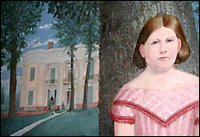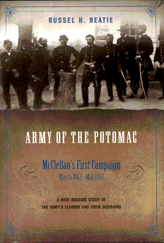A friend is clearing shelf space. I'm posting a list the ACW part of the collection he wishes to sell as a list below. If interested in some or all tieles let me know and I will put you in touch with the seller. You can write to me at this address:
keepartreal [at] yahoo [dot] com
Never say this is not a full service blog.
Here's the list:Adams, Charles S. The Monuments at Antietam: Sharpsburg’s Silent Sentinels. Dagsboro, De.: the author, 2001.
Adams, Charles S. The Civil War in Washington County Maryland: A Guide to 66 Points of Interest. privately printed, 1996.
Armstrong, Marion V. Disaster in the West Woods: General Edwin V. Sumner and the II corps at Antietam. Sharpsburg, Md., Western Maryland Interpretive Assn., 2002.
Barrow, High W. Private James R. Barrow and Company B, Cobb’s Legion Infantry. privately printed, 1998.
Bedwell, Randall, ed. May I Quote You, General Lee? Observations & Utterances from the South’s Great General. Nashville, Tenn., Cumberland House, 1997.
Bernard, George S., comp. & ed. War Talks of Confederate Veterans. Petersburg, Va.: Fenn & Owen, Publishers, 1892.
Boatner, Lt. Col. Mark M. The Civil War Dictionary. New York: David McKay Company, 1959.
Campaign Chronicles: The Campaign for Atlanta & Sherman’s March to the Sea: Essays on the 1864 Georgia Campaign, Volume 1. Campbell, Calif.: Savas Woodbury Publishing, 1992.
Chesapeake and Ohio Canal: A Guide to Chesapeake and Ohio Canal National Historical Park, Maryland, District of Columbia and West Virginia. Washington, D.C.: Division of Publications, National Park Service, 1991.
Coddington, Edwin B. The Gettysburg Campaign: A Study in Command. New York: Charles Scribner’s Sons, 1979.
Connelly, Thomas L., Civil War Tennessee: Battle and Leaders. Knoxville: The Univ. of Tennessee Press, 1979.
Cooper, William J., intro. Thirty Years After: An Artist’s Memoir of the Civil War, Text and Illustrations by Edwin Forbes. Baton Rouge: Louisiana State Univ. Press, 1993.
Cox, Jacob D. The Battle of Franklin, Tennessee, November 30, 1864, A Monograph. Dayton, O.: Morningside Press, 1983.
Cox, Jacob D. The March to the Sea, Franklin and Nashville. Wilmington, N.C.: Broadfoot Publishing, 1989.
Davis, William C. Rebels & Yankees: The Battlefields of the Civil War. New York: Smithmark Publishers, 1991.
Davis, William C. Rebels & Yankees: The Fighting Men of the Civil War. New York: Smithmark Publishers, 1989.
Davis, William C. Rebels & Yankees: The Commanders of the Civil War. New York: Smithmark Publishers, 1990.
Dyer, Frederick H. A Compendium of the War of the Rebellion. 3 vols., New York: Thomas Yoseloff, 1959.
Ellingson, Paul, ed. Confederate Flags in the Georgia State Capitol Collection. Atlanta: Office of the Secretary of State Max Cleland, 1994.
Fonvielle, Chris E., The Wilmington Campaign: Last Rays of Departing Hope. Campbell, Calif.: Savas Publishing, 1997.
Frassanito, William A. Antietam: The Photographic Legacy of America’s Bloodiest Day. New York: Charles Scribner’s Sons, 1978.
Frassanito, William A. Gettysburg: A Journey in Time. New York: Charles Scribner’s Sons, 1975.
Gallagher, Gary W., ed. Antietam: Essays on the 1862 Maryland Campaign. Kent, O.: Kent State Univ. Press, 1989.
Gardner, Alexander. Gardner’s Photographic Sketch Book of the Civil War. New York: Dover Publications, 1959.
George, Kathleen R. The Location of the Monuments, Markers, and Tablets on Gettysburg Battlefield. Eastern National Park and Monument Association, 1984.
Gilbert, David T. A Walker’s Guide to Harpers Ferry, West Virginia: Exploring a Place Where History Still Lives. Harpers Ferry: Harpers Ferry Historical Association, Fifth Edition, 1995.
Harsh, Joseph L. Confederate Tide Rising: Robert E. Lee and the Making of Southern Strategy, 1861-1862. Kent, O.: The Kent State University Press, 1998.
_____________. Taken at the Flood: Robert E. Lee and Confederate Strategy in the Maryland Campaign of 1862. Kent, O.: The Kent State University Press, 1999.
_____________. Sounding the Shallows: A Confederate Companion for the Maryland Campaign of 1862. Kent, O.: The Kent State University Press, 2000.
History and Tour Guide of the Antietam Battlefield by the Editors of Blue & Gray Magazine with Stephen W. Sears and James V. Murfin. Columbus, O.: Blue & Gray Magazine, 1995.
Holien, Kim B. Battle at Ball’s Bluff: The Fateful Clash of North and South at Leesburg, Virginia -- October 21, 1861. Publisher’s Press, 1985.
Holzer, Harold and Mark E. Neely, Mine Eyes Have Seen the Glory: The Civil War in Art. New York: Orion Books, 1993.
John Brown’s Raid. National Park Service History Series. Washington, D.C.: 1974.
Johnson, Curt and Richard C. Anderson. Artillery Hell: The Employment of Artillery at Antietam. College Station, Tx.: Texas A&M Univ. Press, 1995.
Johnson, Robert U. and Clarence C. Buel, eds., Battles and Leaders of the Civil War. 4 vols., reprint, New York: Castle Books, 1956.
Jones, Howard. Union in Peril: The Crisis over British Intervention in the Civil War. Chapel Hill: Univ. of North Carolina Press, 1992.
Jones, Wilbur D. Giants in the Cornfield: The 27th Indiana Infantry. Shippensburg, Pa., White Mane Publishing, 1997.
Kelly, Dennis. Kennesaw Mountain and the Atlanta Campaign, A Tour Guide by Dennis Kelly. Marietta, Ga., Kennesaw Mountain Historical Assn., 1990.
Lacovara, Robert R. Regimental Flags and History of the New Jersey Volunteers during the Civil War. privately printed, 1993.
Luvaas, Jay and Harold W. Nelson. The U.S. Army War College Guide to the Battle of Antietam, The Maryland Campaign of 1862. Carlisle, Pa.: South Mountain Press, 1987.
Mahin, Dean B., One War at a Time: The International Dimensions of the American Civil War. Washington, D.C.: Brassey’s, 1999.
Marvel, William. Burnside. Chapel Hill: Univ. of North Carolina Press, 1991.
Maurois, Andre and Gen. James M. Gavin. A Civil War Album of Paintings by the Prince de Joinville. New York: Atheneum, 1964.
MacLachlan, Renae. A Lion to the Last: Lt. William J. Fisher and the 10th U.S. Infantry; Paths of Heroes, No. 1. Gettysburg, Pa.: Friends of the National Parks at Gettysburg, 2003.
McClellan, George B. McClellan’s Own Story. Scituate, Mass.: Digital Scanning, Inc., 1998.
McDonough, James Lee and Thomas L. Connelly, Five Tragic Hours: The Battle of Franklin. Knoxville: The Univ. of Tennessee Press, 1983.
Miles, Jim. Fields of Glory: A History and Tour Guide of the Atlanta Campaign. Nashville, Tenn., Rutledge Hill Press, 1989.
Murfin, James V. The Gleam of Bayonets: The Battle of Antietam and the Maryland Campaign of 1862. Baton Rouge: Louisiana State University Press, 2nd printing, 1985.
Newell, Clayton R. Lee vs. McClellan: The First Campaign. Washington, D.C.: Regnery Publishing, 1996.
Nosworthy, Brent. The Bloody Crucible of Courage: Fighting Methods and Combat Experience of the Civil War. New York: Carroll & Graf Publishers, 2003.
Palfrey, Francis W. The Antietam and Fredericksburg. [1882]. Wilmington, N.C.: Broadfoot Publishing, 1989.
Price, William H. The Civil War Handbook. Fairfax, Va.: Prince Lithograph Co., 1961.
Priest, John M. Before Antietam: The Battle for South Mountain. Shippensburg, Pa.: White Mane Press, 1992.
Rafuse, Ethan S. McClellan’s War: The Failure of Moderation in the Struggle for the Union. Bloomington: Indiana University Press, 2005.
Ray, Frederick E. “Our Special Correspondent: Alfred R. Waud’s Civil War. Mechanicsburg, Pa.: Stackpole Books, 1994.
Reilly, Oliver T. The Battlefield of Antietam. Hagerstown, Md.: Hagerstown Bookbinding & Printing, reprint, no date.
The Returned Battle Flags: Presented to the Confederate Veterans at their Reunion, Louisville, Ky., June 14th, 1905, with the Compliments of the Passenger Department, “Cotton Belt Route”. privately printed, 1905, reprint, Redondo Beach, Calif.: Rank and File Publications, 1995.
Ridgway, James M. Little Mac: Demise of an American Hero. Xlibris Corp., 2000.
Sauers, Richard A. Advance the Colors! Pennsylvania Civil War Battle Flags. 2 vols. Harrisburg: Capitol Preservation Committee, 1987, 1991.
Scaife, William R. The Campaign for Atlanta. Atlanta: the author, 1993.
Schildt, John W. Four Days in October. Chewsville, Md.: published by the author, 1978.
Sears, Stephen W. The Civil War Papers of George B. McClellan: Selected Correspondence, 1860-1865. New York: Ticknor & Fields, 1989.
Sears, Stephen W. Landscape Turned Red: The Battle of Antietam. New Haven: Ticknor & Fields, 1983.
Sears, Stephen W., ed. The American Heritage Century Collection of Civil War Art. New York: McGraw-Hill Book Co., 1974.
Snell, Mark A. From First to Last: The Life of Major General William B. Franklin. New York: Fordham University Press, 2002.
Snell, Mark A., ed. Civil War Regiments: A Journal of the Civil War, Volume 5, No. 3, Antietam: The Maryland Campaign of 1862. Campbell, Calif.: Savas Publishing, 1997.
Snell, Mark A., ed. Civil War Regiments: A Journal of the Civil War, Volume 6, No. 2, The Maryland Campaign and Its Aftermath. Campbell, Calif.: Savas Publishing, 1998.
Stegeman, John F. These Men She Gave: Civil War Diary of Athens, Georgia. Athens: University of Georgia Press, 1964, reprint, Athens: Univ. of Georgia Press, no date.
Stewart, George R. Pickett’s Charge: A Microhistory of the Final Attack at Gettysburg, July 3, 1863. Boston: Houghton Mifflin Co., 1987.
Sword, Wiley. Embrace an Angry Wind: The Confederacy’s Last Hurrah: Spring Hill, Franklin, and Nashville. Columbus, O.: The General’s Books, 1994.
Tilberg, Frederick. Antietam: Antietam National Battlefield; Historical Handbook No. 31. Washington D.C.: Government Printing Office, no date.
United States Government. War Department. The War of the Rebellion: A Compilation of the Official Records of the Union and Confederate Armies. 128 vols. and Atlas, Washington, D.C.: Government Printing Office, 1880-1901. Volume 19, Parts 1 & 2, The 1862 Maryland Campaign, reprint, Harrisburg, Pa.: National Historical Society, 1971.
__________________. Atlas to Accompany the Official Records. reprint, New York: The Fairfax Press, 1978.
Voices of the Civil War: Antietam. Alexandria, Va.: Editors of Time-Life Books, 1996.
Voices of the Civil War: Atlanta. Alexandria, Va.: Editors of Time-Life Books, 1996.
Wiggins, David N. Images of America: Remembering Georgia’s Confederates. Charleston, S.C.: Arcadia Publishing, 2005.
Wright, Steven J. Imports from the United Kingdom: 1861-1865. privately printed, no date.









